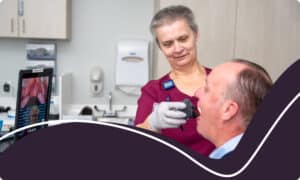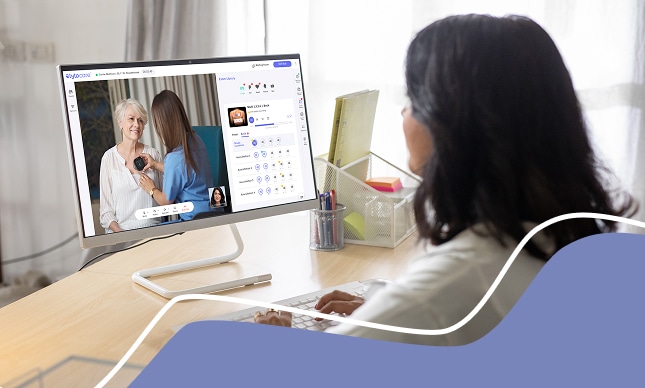AI Meets the Frontline: How Clinically-Vetted AI is Powering Better Respiratory Exams

When it comes to diagnosing asthma, bronchitis, or COPD, frontline clinicians often rely on what they can hear – literally. But what happens when those key respiratory sounds are faint, subjective, or missed altogether? That’s where AI-powered respiratory exams are changing the game.
At TytoCare, we’ve combined clinical expertise with cutting-edge technology to build the TytoCare Lung Suite, a first-of-its-kind AI system that identifies wheezes, crackles, and rhonchi during remote exams. This means faster decisions, greater confidence, and better outcomes, especially for people managing chronic respiratory conditions.
Let’s take a closer look at how clinically vetted AI is bringing precision to the frontlines of care.
Why Lung Sounds Matter, and Why They’re Often Missed
If you’ve ever used a stethoscope, you know the complexities involved. Detecting subtle signs like a wheeze or crackle takes trained ears, and even then, interpretation can vary widely.
One recent study found that primary care providers and specialists often disagree when listening to the same lung sounds. The stakes are high: delayed or inaccurate diagnosis of respiratory issues can lead to missed care opportunities, overuse of emergency services, and poor chronic condition management.
That’s why objective, AI-assisted lung sound analysis is so powerful. It’s not just about identifying sounds; it’s about doing so consistently and accurately, no matter where care happens.
Inside the TytoCare Lung Suite: How AI-Powered Respiratory Exams Work
TytoCare’s AI isn’t just “smart,” it’s clinically trained. Built on a dataset of over 7 million remote exams, our system uses a deep neural network architecture to detect abnormal lung sounds with exceptional precision.
Here’s how it works:
- Data Collection at Scale: We collect real-world respiratory audio from diverse patient populations using the Tyto device during virtual respiratory exams.
- Clinical Labeling: Pulmonologists and other respiratory experts label the data to create an authoritative training set.
- Model Ensemble: Multiple AI models, each optimized for specific sound patterns, work together to identify wheeze, crackles, and rhonchi with impressive accuracy.
- FDA Clearance: Each algorithm goes through rigorous testing and validation, achieving FDA 510(k) clearance for clinical use
The result? AI in respiratory care that providers can actually trust.
The Accuracy Speaks for Itself
We tested our AI-powered respiratory exams against both general practitioners and medical specialists. The results*:
- AI AUC Score: 95.85%
- Specialists AUC Score: 83.03%
- PCPs AUC Score: 79.45%
In short, our AI performs at, or above, the level of experienced clinicians. That’s a game-changer for remote respiratory diagnosis.
Supporting the Frontline: From School Nurses to Remote Clinics
Whether it’s a school nurse in rural Arkansas or a telehealth provider in a busy urban system, AI support for lung exams is reshaping how care is delivered:
- A school nurse hears faint wheezing and uses TytoCare’s clinician platform to confirm what the AI flagged.
- A child with asthma gets a timely treatment adjustment without ever leaving the school.
- A parent conducts an exam at home using TytoHome, and the AI detects rhonchi, prompting a telehealth visit instead of an ER trip.
In fact, in one TytoCare school-based study, 27% of parents would have visited the ER if TytoCare hadn’t been available on-site, and 45% would have gone to urgent care.
Health System Benefits: Smarter, Faster, More Scalable Respiratory Care
For providers and payers, the impact of AI in telehealth goes beyond the individual exam. With the TytoCare Lung Suite, organizations can:
- Empower non-specialist clinicians (e.g. school nurses, telepresenters, urgent care RNs) with real-time diagnostic support.
- Reduce unnecessary in-person visits and escalate only the cases that need it.
- Improve quality scores by supporting earlier detection and better asthma control.
- Close care gaps in asthma and COPD management, especially in underserved areas.
It’s also a key tool for health plans focused on value-based care and chronic disease prevention.
What’s Next: The Future of AI in Respiratory Care
AI is no longer just a tool for tech-savvy startups or tertiary hospitals. It’s becoming a vital component of frontline care. As we continue to expand our AI capabilities across new clinical domains, we’re focused on one thing: making care more accurate, equitable, and accessible for everyone.
With the TytoCare Lung Suite, we’re not just helping providers detect respiratory issues. We’re helping them do it earlier, more confidently, and from anywhere.
Whether you’re looking to improve remote respiratory diagnosis, scale school health programs, or reduce ER visits for asthma, the TytoCare Lung Suite is ready to help. Get in touch to learn more about bringing AI-powered lung exams to your organization.
* The FDA’s clearance was supported by evidence demonstrating that the algorithm is as good as primary care clinicians at identifying wheezes, crackles, and rhonchi. In an analysis of internal retrospective real-world data, Tyto Insight algorithms demonstrated better performance compared to GPs and pulmonologists.





